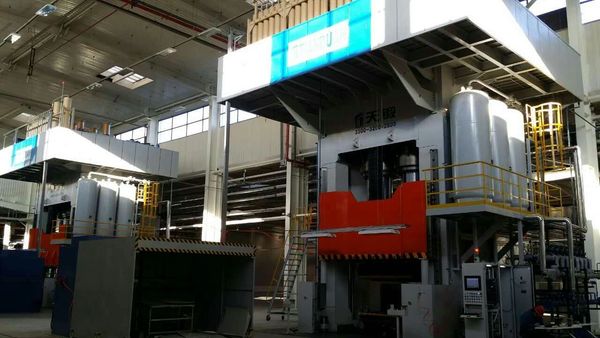SMC Composite Hydraulic Presses
SMC tractor body part made on 3000 Ton Hydraulic Press
SMC Hydraulic Press Mold with Die Cart for easy loading and unloading of mold on the hydraulic press

3000 Ton Hydraulic Press

Truck front panel made of SMC material which is molded on 2500 Ton Hydraulic Press
2400 Ton Hydraulic Press for SMC application
SMC HYDRAULIC PRESS COMPRESSION MOULDING
Range 500 Ton to 6000 Ton
Hydraulic presses are widely used in the production of Sheet Moulding Compound (SMC), a composite material made of a mixture of resin and reinforcement fibers. The use of hydraulic presses in the compression of SMC allows for the production of high-quality, consistent parts with precise dimensional accuracy.
SMC is a cost-effective alternative to traditional metal forming processes, as it requires less energy and labor to produce parts, and can also result in lighter weight and improved surface finishes.
The compression process for SMC involves placing the mixture of resin and reinforcement fibers into a mold, which is then closed by the hydraulic press. The high-pressure fluid from the press exerts force on the material, causing it to flow and fill the mold. The material is then cured under pressure, resulting in a solid part.
Hydraulic presses used for SMC compression come in various sizes and capacities, and can be designed for specific applications or production requirements. Some common hydraulic presses used for SMC compression include:
- Four-Column Hydraulic Presses: These hydraulic presses are equipped with four columns, two on each side of the mold, that support the press platen. They are ideal for larger, heavier molds and offer a higher degree of stability compared to other types of hydraulic presses.
- C-Frame Hydraulic Presses: These hydraulic presses feature a C-shaped frame that supports the press platen, and are well-suited for smaller molds and lighter duty applications.
- High-Speed Hydraulic Presses: These hydraulic presses are designed for high-speed production and are equipped with advanced control systems that allow for quick and accurate pressure adjustments. They are ideal for applications where high-volume production is required.
Regardless of the type of hydraulic press used, it is important to ensure that the press is properly maintained to ensure consistent and reliable performance. Regular maintenance should include checks of the hydraulic system for leaks, the wear and tear of moving parts, and the accuracy of pressure readings.
In conclusion, hydraulic presses play a crucial role in the compression of SMC, providing the necessary force to mold the material into a solid part. With advances in hydraulic press technology, SMC compression has become an efficient and cost-effective alternative to traditional metal forming processes, and offers improved part quality, weight reduction, and surface finishes.
Active levelling and parallelism control are critical features in SMC hydraulic presses, as they ensure that the mold is properly aligned and level during the compression process. This helps to reduce the risk of misalignment, which can result in defects in the finished part and can also damage the press and mold.
Active levelling control uses sensors and a control system to monitor the position of the mold and adjust it as needed to maintain a level surface. This is particularly important in applications where the mold is subject to uneven loading or settling, as it helps to ensure that the material is evenly distributed within the mold and that the compression process is consistent.
Parallelism control, on the other hand, ensures that the two sides of the mold are parallel to each other, which helps to prevent the material from flowing unevenly and causing defects in the finished part. This is particularly important in applications where the mold is subject to lateral forces during the compression process, as it helps to ensure that the mold remains properly aligned throughout the process.
The active levelling and parallelism control system in SMC hydraulic presses typically includes sensors that monitor the position of the mold and a control system that adjusts the position of the mold as needed. The control system can be programmed to automatically maintain the level and parallel position of the mold, or it can be manually adjusted by the operator as needed.
In order to ensure the proper functioning of the active levelling and parallelism control system, it is important to regularly check the sensors and control system for accuracy and to perform any necessary maintenance or repairs. Additionally, the control system should be programmed with the correct parameters for the specific application, as this will help to ensure optimal performance and consistent results.
In conclusion, active levelling and parallelism control are critical features in SMC hydraulic presses that help to ensure the proper alignment of the mold and the consistent compression of the material. Proper maintenance and control of these features is essential to ensure the production of high-quality, consistent parts, and to reduce the risk of damage to the press and mold.
HIND PRESSES AND AUTOMATION PRIVATE LIMITED
17, Ground Floor, Ozone Centre, Sector 12, Faridabad, 121007, Haryana, India
Copyright © 2023 Tianduan - All Rights Reserved.
Powered by HIND
This website uses cookies.
We use cookies to analyze website traffic and optimize your website experience. By accepting our use of cookies, your data will be aggregated with all other user data.